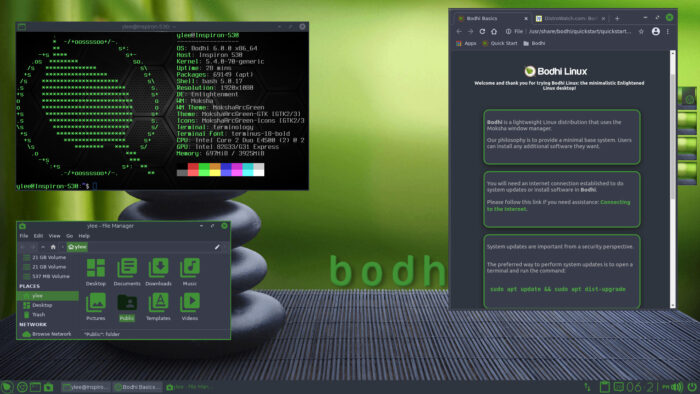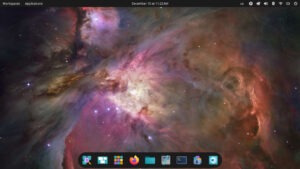New users of Bodhi Linux might be confused about which of the four available ISO images to use. We’ve got your back.

Bodhi Linux has a new release — version 7.0.
That’s what we heard on Monday from Robert Wiley, who’s been the lead developer for the minimalist Debian-based Linux distribution since the project’s founder, Jeff Hoogland, left in 2019, evidently to become a fulltime video streamer on Twitch.tv.
In the headline to Wiley’s notice, he calls Bodhi’s latest and greatest “a landmark release,” and in the opening sentence he says the release is “a momentous step forward.” That’s a lot of superlatives for a distro who’s purpose is to be minimalistic.
However, according to the reviews I’ve been reading, it’s probably a pretty apt description. Everybody I’ve read so far likes the release, even if one well-meaning editor evidently misunderstood his writer and turned superlative into hyperbole with a headline that said it “challenges Microsoft Windows 11,” which is one thing the distro doesn’t even try to do.
What it does try to do, and accomplishes well, is exactly what the writer said: it offers “a true alternative to proprietary solutions like Microsoft Windows.”
Bodhi and Me
I used Bodhi as my goto distro for a year or so about about a decade ago. I liked it quite a bit, even though I always knew that Bodhi and me weren’t destined to ever become longtime lovers or anything. Mainly, I think I liked the idea of Bodhi more than I liked the distro itself — although there was nothing wrong with the distro.
I’m a Buddhist, or more precisely, kind of half a Buddhist (with the other half being various Western pagan philosophies that meld well with Buddhism), so the name “Bodhi” attracted me to the distro, because legend has it that the original Buddha, Shakyamuni, attained enlightenment while sitting beneath a bodhi tree, which has resulted in the word “bodhi” now meaning “awakening” or “enlightenment” (and a Buddha in training is a bodhisattva).
When Hoogland founded the distro, he undoubtedly was going after the “enlightenment” thing, because the original purpose of the distro he built was to showcase the use of the compositing window manager Enlightenment, also known as E, as a desktop.
At the time, Enlightenment was under really slow development. It had gotten started in 1997, with version E16, and 14 years later when Bodhi was first coming out, Enlightenment’s next version, E17, was just being released. Hoogland evidently expected this slow development of Enlightenment to continue and seemed to be caught by surprise when E18 was released only a couple of years later, in 2014.
Also surprising to Bodhi’s dev team were the number of changes made to E18, enough to make it largely not backwards compatible with E17. This was not good for Bodhi, especially since the folks at Enlightenment were already talking about their next release, E19, coming out in about a year with even more radical changes in store.
Hoogland’s solution was to fork E17 to create the Moksha desktop, which is still under active development and which in many ways represents the heart of Bodhi Linux.
Four ISO Image Choices
Much like Debian, Bodhi offers users a a number of choices of ISO images to download and install. In this case, there are four choices: Standard, HWE, s76, and AppPack, with all of the images being based-on Standard.
Bodhi Linux Standard is Bodhi’s flagship version that the project’s website says is meant for computers “created in the last decade.” According to Bodhi, if you have a 64-bit machine, “you should be using this release.”
In keeping with Bodhi’s minimalist philosophy “to allow users to add exactly what they want with no frills included by default,” Standard installs with a minimum default application set:
- Terminology Terminal Emulator
- Chromium Web Browser
- Thunar File Manager with archive plugin
- Leafpad Text Editor
- ePhoto Image Viewer
- aRandr Monitor Settings
- Web Browser Manager
- Engrampa File Archiver
- Pavucontrol Pulse Audio Control
- Gnome Language Selector
- Synaptic Package Manager
This image features the 5.15.0-78 LTS kernel.
While this version is Bodhi’s default (and the only ISO that’s available as we go to press — the others are “coming soon”) I’m betting that most users are going to want to wait and opt for AppPack when it’s ready.
HWE (Hardware Enablement) is for users with equipment that requires newer hardware support than what’s available in Standard. It also features the much newer (but not LTS) 6.2.0-26 kernel.
s76 features a more bleeding-edge kernel than the HWE release provides, which I guess makes it Bodhi’s equivalent of Debian’s Sid (although there’s nothing mentioned about it being “unstable”).
“If your processor is capable of running a 64-bit operating system, and your hardware support is so new not even the HWE kernel supports it, you should be using this release,” the Bodhi devs say.
AppPack is like Standard, but it comes with a variety of additional themes and applications, which is why I’m betting that most users will want to wait until this one is ready for download:
- Accessories
- Games
- Graphics
- Internet
- Sound & Video
- Audacious
- VLC Media Player
- Pavucontrol Pulse Audio Control
- Office
- Libre Office
- Evince Document Viewer
- System Tools
- Printer Support
- Timeshift (system restore utility)
- Update Manager
- Synaptic Package Manager
- Terminology Terminal Emulator
While the Standard and AppPack versions default to the 5.15.0-78 LTS kernel which reaches end-of-life in 2026, both releases allow kernel updates post-installation, so those preferring the newer 6.2.0-26 kernel can add HWE kernel updates to either Standard or AppPack releases post-installation. For more details see the distro’s wiki article on How to add HWE to an AppPack Installation.
Again, as we go to press the only ISO that is downloadable is Standard, which is available here. When available, links to the other ISO versions will be available here. We’ll update this article as soon as we know they’re available.
Christine Hall has been a journalist since 1971. In 2001, she began writing a weekly consumer computer column and started covering Linux and FOSS in 2002 after making the switch to GNU/Linux. Follow her on Twitter: @BrideOfLinux







